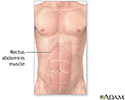Diastasis recti
Diastasis recti is a separation between the left and right side of the rectus abdominis muscle. This muscle covers the front surface of the belly area.
Causes
Diastasis recti is common in newborns. It is seen most often in premature and African American infants.
Pregnant women may develop the condition because of increased tension on the abdominal wall. The risk is higher with multiple births or many pregnancies.
Symptoms
A diastasis recti looks like a ridge, which runs down the middle of the belly area. It stretches from the bottom of the breastbone to the belly button. It increases with muscle straining.
In infants, the condition is most easily seen when the baby tries to sit up. When the infant is relaxed, you can often feel the edges of the rectus muscles.
Diastasis recti is commonly seen in women who have multiple pregnancies. This is because the muscles have been stretched many times. Extra skin and soft tissue in the front of the abdominal wall may be the only signs of this condition in early pregnancy. In the later part of pregnancy, the top of the pregnant uterus can be seen bulging out of the abdominal wall. An outline of parts of the unborn baby may be seen in some severe cases.
Exams and Tests
The health care provider can diagnose this condition with a physical exam.
Treatment
No treatment is needed for pregnant women with this condition.
In infants, diastasis recti will disappear over time. Surgery may be needed if the baby develops a hernia that becomes trapped in the space between the muscles.
Hernia
A hernia is a sac formed by the lining of the abdominal cavity (peritoneum). The sac comes through a hole or weak area in the strong layer of the be...

Outlook (Prognosis)
In some cases, diastasis recti heals on its own.
Pregnancy-related diastasis recti often lasts long after the woman gives birth. Exercise may help improve the condition. Umbilical hernia may occur in some cases. Surgery is rarely performed for diastasis recti.
Possible Complications
In general, complications only result when a hernia develops.
When to Contact a Medical Professional
Call your health care provider right away if a child with diastasis recti:
- Develops redness or pain in the abdomen
- Has vomiting that does not stop
- Cries all the time
References
Turnage RH, Badgwell B. Abdominal wall, umbilicus, peritoneum, mesenteries, omentum, and retroperitoneum. In: Townsend CM Jr, Beauchamp RD, Evers BM, Mattox KL, eds. Sabiston Textbook of Surgery . 19th ed. Philadelphia, PA: Elsevier Saunders; 2012:chap 45.
-
Diastasis recti - illustration
Diastasis recti, a normal condition in newborns, is a separation of the left and right side of the rectus abdominis muscle, which is the muscle covering the front surface of the abdomen. A diastasis recti is seen as a large ridge running down the midline of the abdomen from the bottom of the breastbone to the navel which appears whenever an infant strains or attempts to sit up.
Diastasis recti
illustration
-
Abdominal muscles - illustration
The abdominal muscles are comprised of the internal, external, and oblique abdominal muscles.
Abdominal muscles
illustration
-
Diastasis recti - illustration
Diastasis recti, a normal condition in newborns, is a separation of the left and right side of the rectus abdominis muscle, which is the muscle covering the front surface of the abdomen. A diastasis recti is seen as a large ridge running down the midline of the abdomen from the bottom of the breastbone to the navel which appears whenever an infant strains or attempts to sit up.
Diastasis recti
illustration
-
Abdominal muscles - illustration
The abdominal muscles are comprised of the internal, external, and oblique abdominal muscles.
Abdominal muscles
illustration
Review Date: 4/5/2015
Reviewed By: Debra G. Wechter, MD, FACS, General Surgery practice specializing in breast cancer, Virginia Mason Medical Center, Seattle, WA. Also reviewed by David Zieve, MD, MHA, Isla Ogilvie, PhD, and the A.D.A.M. Editorial team.


